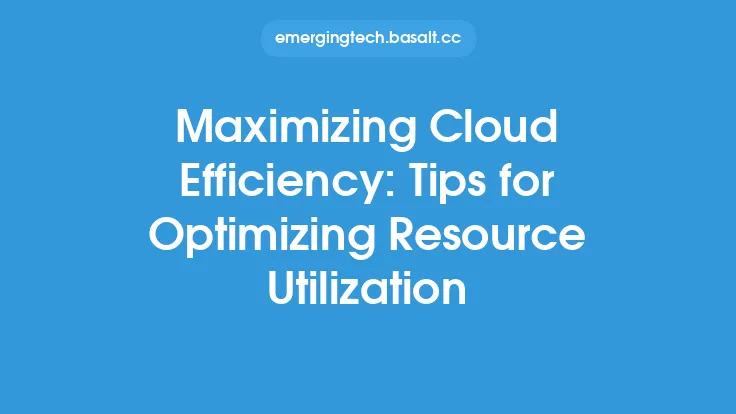Cloud scalability is a critical aspect of cloud computing, as it enables businesses to efficiently utilize resources and adapt to changing demands. To achieve efficient resource utilization, it's essential to implement cloud scalability patterns that are tailored to the specific needs of an organization. In this article, we'll delve into the best practices for cloud scalability, exploring the key patterns and strategies that can help businesses optimize their resource utilization.
Introduction to Cloud Scalability Patterns
Cloud scalability patterns refer to the design principles and strategies used to build scalable cloud systems. These patterns are designed to help businesses efficiently utilize resources, such as compute power, storage, and networking, while minimizing waste and optimizing performance. By implementing cloud scalability patterns, organizations can ensure that their cloud resources are utilized in a way that is both efficient and effective.
Load Balancing and Autoscaling
Load balancing and autoscaling are two critical cloud scalability patterns that enable businesses to efficiently manage traffic and resource utilization. Load balancing involves distributing incoming traffic across multiple resources, such as servers or instances, to ensure that no single resource is overwhelmed. Autoscaling, on the other hand, involves dynamically adjusting the number of resources based on changing demand. By combining load balancing and autoscaling, businesses can ensure that their resources are utilized efficiently, even in the face of fluctuating demand.
Caching and Content Delivery Networks
Caching and content delivery networks (CDNs) are two cloud scalability patterns that can help businesses reduce the load on their resources and improve performance. Caching involves storing frequently accessed data in a cache, which can be retrieved quickly and efficiently. CDNs, on the other hand, involve distributing content across multiple locations, reducing the distance between users and the content they need to access. By implementing caching and CDNs, businesses can reduce the load on their resources, improve performance, and enhance the user experience.
Database Scalability
Database scalability is a critical aspect of cloud scalability, as databases are often the bottleneck in many cloud systems. To achieve database scalability, businesses can implement a range of strategies, including sharding, replication, and partitioning. Sharding involves dividing a database into smaller, more manageable pieces, while replication involves creating multiple copies of a database to improve availability and performance. Partitioning, on the other hand, involves dividing a database into smaller, more focused pieces, to improve query performance and reduce latency.
Queue-Based Architecture
Queue-based architecture is a cloud scalability pattern that involves using message queues to decouple applications and services. By using message queues, businesses can create a buffer between applications and services, allowing them to process requests and messages at their own pace. This can help to improve performance, reduce latency, and enhance the overall scalability of a cloud system. Queue-based architecture is particularly useful in systems where there are multiple applications and services that need to communicate with each other.
Microservices Architecture
Microservices architecture is a cloud scalability pattern that involves breaking down applications into smaller, more focused services. Each service is designed to perform a specific function, and can be developed, deployed, and scaled independently. By using microservices architecture, businesses can create cloud systems that are more agile, flexible, and scalable. Microservices architecture is particularly useful in systems where there are multiple applications and services that need to be integrated and coordinated.
Containerization and Orchestration
Containerization and orchestration are two cloud scalability patterns that can help businesses improve the efficiency and effectiveness of their cloud resources. Containerization involves packaging applications and services into containers, which can be deployed and managed consistently across different environments. Orchestration, on the other hand, involves automating the deployment, scaling, and management of containers. By using containerization and orchestration, businesses can create cloud systems that are more agile, flexible, and scalable.
Monitoring and Optimization
Monitoring and optimization are critical aspects of cloud scalability, as they enable businesses to identify areas for improvement and optimize their resource utilization. By monitoring cloud resources and applications, businesses can identify bottlenecks, optimize performance, and improve the overall efficiency of their cloud systems. Optimization involves using data and analytics to identify areas for improvement, and implementing changes to improve performance, reduce waste, and enhance the overall scalability of a cloud system.
Security and Compliance
Security and compliance are essential aspects of cloud scalability, as they enable businesses to protect their data and applications while ensuring regulatory compliance. By implementing security and compliance measures, such as encryption, access controls, and auditing, businesses can ensure that their cloud resources and applications are secure and compliant with relevant regulations. Security and compliance are critical aspects of cloud scalability, as they enable businesses to build trust with their customers and stakeholders.
Conclusion
Cloud scalability patterns are essential for businesses that want to efficiently utilize their cloud resources and adapt to changing demands. By implementing load balancing and autoscaling, caching and CDNs, database scalability, queue-based architecture, microservices architecture, containerization and orchestration, monitoring and optimization, and security and compliance, businesses can create cloud systems that are more agile, flexible, and scalable. By following these best practices, businesses can optimize their resource utilization, improve performance, and enhance the overall scalability of their cloud systems.





